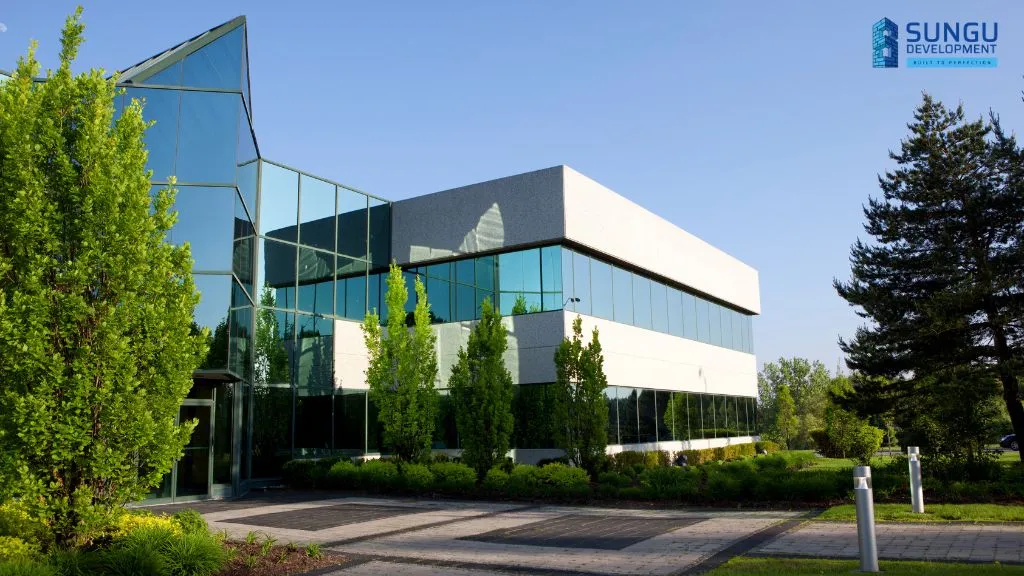
Choosing the right commercial construction materials determines how safe, durable, efficient, and future-proof a building will be. From the structural frame to the finishes you see and touch, every choice affects cost, schedule, energy performance, and compliance.
1. Structural Systems: Framing the Building
The structural frame is the backbone of any commercial project. Here are the most widely used systems:
Structural Steel
- Applications: Office buildings, warehouses, tall structures, long spans.
- Advantages: High strength-to-weight ratio, fast erection with prefabricated members, and easy modifications for tenant fit-outs.
- Considerations: Needs fire protection, corrosion control, and quality bolted/welded connections.
Reinforced Concrete (Cast-in-Place or Precast)
- Applications: Parking decks, mid-rise towers, hospitals, data centers.
- Pros: Excellent fire resistance, stiffness, acoustic performance, and thermal stability.
- Cons: Longer cure times may extend schedules; formwork and shoring increase complexity.
Engineered Wood (Glulam, CLT)
- Applications: Low- to mid-rise offices, schools, retail spaces.
- Pros: Lower embodied carbon, natural warmth, fast panelized installation.
- Cons: Limited heights, requires careful fire and moisture detailing, regional supply variations.
Masonry (CMU Block, Brick)
- Applications: Schools, gyms, utility buildings, and façade veneers.
- Pros: Durable, impact-resistant, excellent for fire-rated walls.
- Cons: Slower and heavier to erect, requires moisture management.
2. Building Envelope: Keeping Weather Out, Comfort In
A well-designed envelope improves energy performance and occupant comfort.
- Curtain Wall & Storefront Systems – Aluminum framing with insulated glazing; curtain walls for large spans, storefronts for smaller openings.
- Cladding Options:
- Metal panels (IMP/ACP) for modern aesthetics and insulation.
- Fiber-cement for durability and cost-effectiveness.
- Precast concrete panels for speed and quality.
- Brick/stone veneer for timeless design.
- Air/Water Control Layers – Membranes, continuous insulation, and proper flashing prevent leaks and mold.
3. Roofing: Protecting the Topside
Roofing systems must balance durability, climate resistance, and energy performance.
- TPO & PVC: Reflective, weldable seams, popular for flat roofs.
- EPDM: Flexible, great in colder climates.
- BUR & Modified Bitumen: Multi-layer durability with proven reliability.
- Standing-Seam Metal Roofs: Ideal for sloped roofs with long service life.
Selection factors include climate, foot traffic, reflectivity, warranty, and integration with rooftop solar.
4. Interior Partitions & Finishes
Commercial interiors require both function and aesthetics:
- Framing & Walls: Cold-formed steel studs with gypsum boards (moisture-resistant, fire-rated, or abuse-resistant).
- Ceilings & Acoustics: Suspended acoustic ceiling tiles, wall panels, and sound-rated doors for noise control.
- Flooring: LVT/LVP for durability, carpet tiles for noise reduction, porcelain tile or polished concrete for heavy traffic.
- Doors & Hardware: Hollow metal, aluminum, or wood veneer depending on fire-rating and design needs.
5. MEP Materials: The Hidden Workhorses
Mechanical, electrical, and plumbing systems keep buildings functional:
- Plumbing: Copper, PEX, CPVC, or cast iron based on application.
- HVAC & Ductwork: Galvanized steel ducts, insulated refrigerant lines, and modern controls.
- Electrical & Low Voltage: EMT conduit, copper wiring, LED lighting, advanced controls, and integrated security/data cabling.
6. Fire & Life Safety
Life safety systems are code-driven and critical for compliance:
- Sprinkler systems (steel or CPVC).
- Fire-rated assemblies with gypsum, mineral wool, and sealants.
- Intumescent coatings for exposed steel.
7. Site & Civil Materials
The site package sets the foundation for long-term performance:
- Paving: Asphalt for flexibility, concrete for heavy traffic.
- Utilities: PVC, HDPE, or ductile iron depending on loads and water quality.
- Retaining Walls: Cast-in-place, segmental block, or reinforced soil systems.
8. Sustainability & Health Considerations
Modern projects emphasize sustainability and wellness:
- Use products with EPDs, HPDs, and low VOC emissions.
- Reduce embodied carbon with optimized concrete mixes, recycled steel, and timber.
- Improve efficiency with better envelopes and heat-pump HVAC.
- Design for future reuse with modular partitions and demountable walls.
9. Steel vs. Concrete vs. Mass Timber: A Quick Comparison
| Attribute | Structural Steel | Reinforced Concrete | Mass Timber (CLT/Glulam) |
|---|---|---|---|
| Speed | Fast erection | Slower (cure time) | Fast with prefabrication |
| Fire Resistance | Needs protection | Inherent mass | Char layer, needs design |
| Spans | Long spans | Very stiff | Moderate spans |
| Modifications | Easy to alter | Difficult | Moderate flexibility |
| Embodied Carbon | Moderate | Higher (unless optimized) | Lower, renewable |
| Aesthetics | Exposed steel | Architectural concrete | Warm, natural look |
10. How to Choose: A Practical Checklist
When selecting materials, consider:
- Occupancy & Use – Office, healthcare, warehouse, or lab?
- Codes & Ratings – Fire, seismic, and acoustic standards.
- Speed to Market – Precast, steel, and modular systems save time.
- Budget & Lifecycle – Compare upfront vs. long-term costs.
- Climate & Exposure – UV, humidity, freeze-thaw cycles.
- Flexibility – Open floor plates, modular partitions.
- Sustainability – Reduce embodied carbon, improve IAQ.
Conclusion
A successful commercial project blends the right structure, envelope, MEP systems, and finishes to meet performance, cost, and code requirements. Start with the building’s purpose, climate, and timeline, then select materials that balance durability, speed, and operational efficiency.
FAQs
Q1: What is the most common structural material in commercial buildings?
Many mid- to high-rise and long-span buildings use structural steel, while parking structures and healthcare often favor reinforced concrete. Low- to mid-rise offices may adopt mass timber for sustainability and speed.
Q2: Are metal studs better than wood in commercial interiors?
Yes—cold-formed steel studs are standard due to noncombustibility, straightness, and compatibility with fire-rated assemblies and tall partitions.
Q3: Which roofing lasts the longest for flat commercial roofs?
Correctly designed and maintained TPO/PVC, EPDM, or BUR/modified bitumen can each deliver long life. Selection depends on climate, foot traffic, warranty, and energy goals.
Q4: How do glazing choices affect energy use?
Insulated low-E glass with thermal breaks and exterior shading significantly cuts cooling loads and glare, improving comfort and code compliance.

